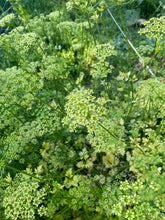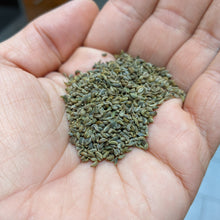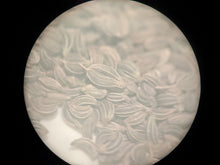'South Ossetia' Parsley (Leaf, Root & Seed Type)
Regular price
$4.00
Sale
Petroselinum crispum
Origin: Kurta, Rayon Tshkhinvali, South Ossetia, Georgia
Improvement status: Landrace
Seeds per packet: ~100
Germination tested 10/2025: 85%
Life cycle: Biennial
If you follow us on social media you know that we are keenly interested in expanding the available diversity of parsley (among many other crops) in the US seed system. After long thinking little about parsley — considering it mainly suited as a garnish — we realized that parsley is really a vegetable, an excellent source of nutrition, and capable of playing a starring role in a range of dishes (especially soups, pastas, and salads). But most every seed company seems to offer only the same few parsley varieties: Italian flat leaf, moss curled, triple curled, or just plain "parsley." So we've plumbed the depths of the USDA's National Plant Germplasm System and come up with some pretty cool parsleys, which we are beginning to roll out with this really exciting landrace from South Ossetia.
The Republic of Georgia in the Caucasus Mountains has not has an easy time since it declared its independence from the Soviet Union in 1991. There have been two major civil wars and multiple skirmishes or periods of high tension, and South Ossetia (along with Abkhazia) is always the major flashpoint. Currently occupied by Russia, but considered part of Georgia by the Georgian government and most of the international community, the Georgia-South Ossetia conflict — which traces back to the earliest days of the Bolshevik Revolution over a century ago — is considered one of the world's most intractable "frozen conflicts."
This special parsley comes from a place that's emblematic of this sad ongoing conflict, specifically the now-abandoned town of Kurta, in the valley of the stream Didi Liakhvi. Kurta was long inhabited by mostly ethnic Georgians, but on the eve of the 2008 Russian invasion, the entire population was evacuated to un-occupied Georgian territory. In the more than 15 years since then, most of the buildings in the town have been destroyed. Due to the ongoing Russian occupation, none of the original inhabitants have returned and Kurta has been left a ghost town.
The parsley itself was collected from a home gardener in Kurta in 1989, presumably by a German scientist. It was donated to the USDA by the German seed bank at Gatersleben in 1997. The narrative accompanying this parsley in the USDA database says only this: "Leaf parsley, old local form (root parsley cultivated in Racha, used in a variety of marinades, vegetables, and also as seasoning, presumed primitive form)." Racha is a mountainous region of Georgia just to the northwest of South Ossetia. Based on this description, and the account of Jen Williams (who grew these seeds for us at Wild Dreams Farm on Vashon Island, Washington), it seems this is a primitive multi-use parsley with edible roots, leaves, and seeds, though the roots are likely not as "refined" as in the Polish root parsley we offer, and the leaves are more strongly flavored than the average parsley. Jen managed to produce a large bag of seeds in 2023, and the seeds are super fragrant and tasty, so we plan to do some experimenting with them in the kitchen this year (parsley seeds are a common spice in some places, but they have largely been forgotten here in the US).
We're excited to be making these seeds available to US growers for the first time — and we hope you're excited to grow them! (Apologies for not having any more photos — Jen's a busy farmer, so sometimes documentation slips through the cracks. Better luck next year!)
GROWING TIPS: Start seeds in flats a few weeks before last frost. Seed-grown parsley starts slowly before eventually taking off. Give plants at least 6 inches of space or more. Parsley is a biennial, so don't expect flowers and seeds until the second year. Should be cold-hardy enough to survive winters outdoors in most of the US.






